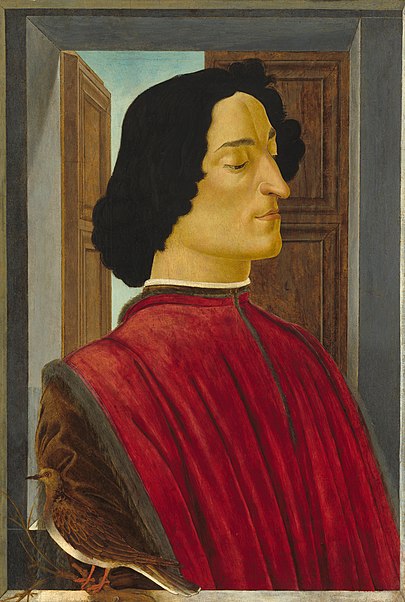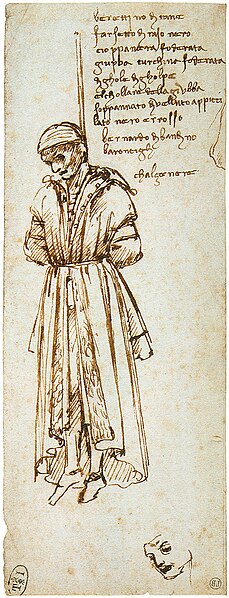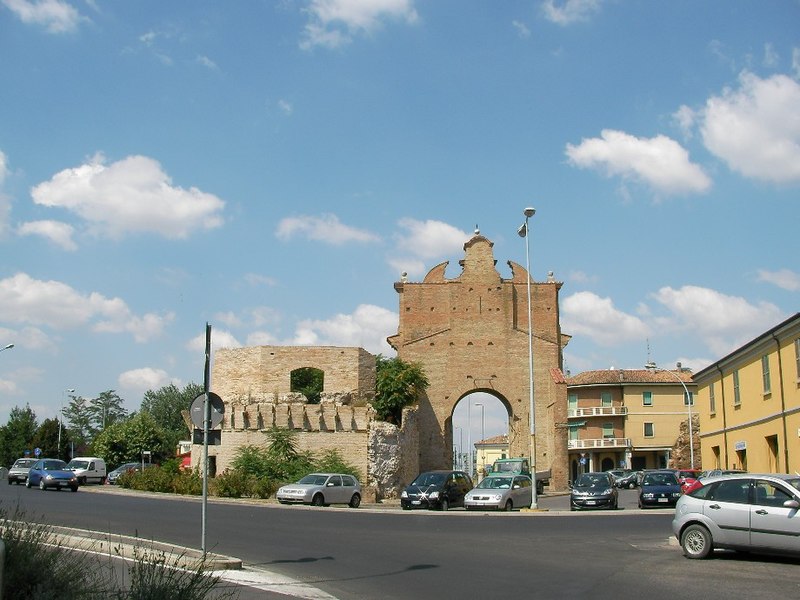 |
| Guidobaldo da Montefeltro |
Girolamo
Riario was a man who made enemies more easily than breathing and he had little understanding of
the meaning of loyalty. Now aged thirty-five Girolamo had become flabby with
the good life. While Caterina was pregnant in Rome, in the spring of 1478 Girolamo
got tied up in a conspiracy to unseat the de’ Medici family from their
stronghold in Florence.
Sixtus was
concerned that Girolamo would find ruling Imola difficult as long as the de’
Medici had power in Florence[ii].
The intention was for Girolamo to extend his rule from Imola across the Romagna. The pope made it quite clear that his support was
conditional; no-one was to die. He told Gina Batista da Montesecco[iii]
and Girolamo;
‘Though Lorenzo is a
villain, and behaves ill towards us, yet we do not on any account desire his
death, but only a change in government.’[iv]
The
conspiracy also involved the Pazzi family who were an old established Florentine family who looked
down on the nouveau arrivé Medici, under the leadership of the head of the family, Jacopo de’ Pazzi and Bishop Salviati[v]. Guidobaldo da Montefeltro. The Duke of Urbino, a family connection of the pope’s, agreed to have 600
men standing by to surround Florence.
The Aftermath
 |
| Guiliano de' Medici |
By
Easter Sunday the conspirators plans were in readiness and on 26th
April when Lorenzo and Guiliano de’ Medici attended the service at the Duomo; Cardinal Raffaele Riario[vi], visiting his uncle Jacopo de’
Pazzi, was a witness to what followed. Guiliano was murdered by a member of the
Pazzi family and one of the family’s clients, but Lorenzo managed to escape
although wounded[vii].
Seeing
Lorenzo’s escape the leading conspirators fled; a track of blood led to the
Pazzi palazzo. Salviati meanwhile went to the Palazzo Vecchio[viii] to allegedly to give Cesare
Petrucci, the Gonfaloniere, a message from the pope. His entourage consisted of
mercenaries who were to take the Signoria by storm, they found themselves unable
to get out of the room where they were waiting for the call from Salviati[ix].
Medici
supporters helped the Gonfaloniere’s
guards finish off the mercenaries. Petrucci himself attacked Salviati with a
cooking spit, the only weapon to hand. Salviati, several Pazzi and other
conspirators were hung from the windows of the Palazzo Vecchio; few escaped the
wrath of the Florentines who rioted despite pleas from Lorenzo for calm.
 |
| Death of a conspirator |
Although
held for a few weeks Raffaele Riario was allowed to leave Florence when it was
clear that he had not been involved after Montesecco confessed his part in the
conspiracy;
‘This command was
given us by the Signor Count [Girolamo] in Rome….we were always told to look
out for the honour of our lord [Pope Sixtus] and of the Count. Thus on Sunday
morning, 26 April 1478, in Santa Liperata [the cathedral of Florence] that was
done which has been made public to the whole world.’[x]
Although
deeply involved in the planning Girolamo had not dared to venture near Florence
and was one of the few who escaped Medici justice, protected by the long arm of
his uncle. He made two more assassination attempts against Lorenzo, both of
which failed.
Forli and Imola
Sixtus
was determined to create a Riario-della Rovere dynasty and. like many popes, exploited
the resources of the papacy to benefit his family. As part of this overreaching
plan, Sixtus made his nephew Lord of Forli[xi] in 1480, The fief had been confiscated from the Ordelaffi family[xii]. In the papal bull granting Forli to
Girolamo Sixtus lauded his nephew’s;
‘Learned experience,
circumspect wisdom, and his shining faith….[charged him to] nurture concord,
treat his subjects kindly, and administer justice to all persons without
exception.’[xiii]
Needless
to say Girolamo had few of the attributes attributed to him by his uncle. Girolamo
was invested as lord of Forli on 31st May as Caterina was giving
birth to Cesare[xiv] in Rome.
 |
| Forli |
Forli
was strategically positioned as the gateway to the Romagna, a part of Italy
that Sixtus was determined would become part of the papal lands. The fortress
at Forli was endowed with the latest technical and mechanical innovations under
the oversight of Girolamo.
It
took a year before Caterina and Girolamo moved to Forli as Sixtus had been
involved in fending off a threatened invasion by the Ottomans. Girolamo had
sent a trusted lieutenant Gian Francesco Maruzzi, to his new lands to act as governor.
The couple’s arrival in July 1481 was greeted with dismay by some elements of
the population still loyal to the Ordelaffi;
‘The Ordelaffis had
entered the city with a mighty wind; now the new lord was entering with fire[xv].’[xvi]
The
coming of their new lord was the occasion of much celebration by the citizens
who were awed by the couple’s display of wealth; they were invited to inspect
the new plate and china[xvii] Caterina and her ladies wore new
dresses every day of the visit. The family then travelled on to Imola where
Girolamo organised the paving of the streets, building towers on the city walls
and pulling down ramshackle dwellings.
War with the d’Esté
Girolamo
may have transformed Imola but he was also physically violent towards Caterina
who was afraid of him. When the Milanese ambassador suggested that Caterina
visit her Sforza relatives she replied;
‘My Lord the Count,
her Consort, had refused it, not without some anger….this would make a breach
between herself and My Lord.’’[xviii]
She
apparently confided to a friend that she envied those who died at their
husband’s hands, something she apparently preferred to living with Girolamo.
 |
| Ercole d'Este |
In September
Caterina and Girolamo left for a visit to Venice, where Girolamo hope to
interest the Venetians in a war against Ferrara and the city’s Duke Ercol d’Esté[xix]. The Venetians were not impressed
with the proposal to fight Ferrara, deeming the pope too weak to successfully
undertake the project.
The
family’s return to the Romagna brought news of two failed plots against them in
Imola and a conspiracy to murder Girolamo in Forli[xx]. The conspirators’ bodies decorated
the city walls to greet the couple’s return. They did not stay long before
returning to Rome.
In the
spring of 1482 Venice declared war on Ferrara over the control of the salt
marshes on the Adriatic coast; Alfonso, the Duke of Calabria and Milan and Florence sided with the d’Esté while Genoa sided with its fellow maritime republic.
 |
| Roberto Malatesta |
Girolamo
was ordered to defend Rome against attack and he set up camp on the Via Appia inside the city walls. He claimed he was ensuring that
the citizens did not revolt. Rumours spread through the city that Girolamo and
his men were dicing on the high altar of St John Lateran, sitting on cases containing sacred
relics collected from throughout Europe and the middle-east.
In
August the Venetians sent their condottiere Roberto Malatesta to help protect the holy city. Duke Alfonso, along with
supporters of the Colonna family, was outside the city and on 20th
August the two sides met in battle at Campo Morto[xxi]; the papal army won the day; much to
Caterina’s chagrin, Girolamo had stayed behind to guard the camp while the troops were led by Malatesta who died of
dysentery nine days after his victory[xxii]. All sides agreed to an armistice in
November.
Bibliography
Italian
Dynasties – Edward Burman, Equation 1989
The Deadly
Sisterhood – Leonie Frieda, Harper Collins 2013
The Rise and
Fall of the Medici – Christopher Hibbert, Folio Society 2001
The Borgias
– Mary Hollingsworth, Quercus Editions Ltd 2014
Tigress of
Forli – Elizabeth Lev, Head of Zeus Ltd, 2012
The Families
Who Made Rome – Anthony Majanlahti, Pimlico 2006
April Blood
– Lauro Martines, Jonathan Cape 2003
The Borgias
– GJ Meyer, Bantam Books 2013
Absolute
Monarchs – John Julius Norwich, Random House 2011
Niccolo’s
Smile – Maurizio Viroli, IB Tauris & Co Ltd 2001
www.wikipedia.en
[ii]
A city coveted by Lorenzo de’ Medici
[iii]
A condottiere who had fought with Girolamo at the 1474 siege of Città di Castello on behalf of the
pope
[iv]
The Rise and Fall of the House of Medici - Hibbert
[v]
Another scion of the Riario family who saw the conspiracy as a route to
becoming Archbishop of Florence
[vi]
Sixtus’ seventeen year old great nephew
[vii]
He was attacked by two priests, unused to using weapons they only managed to
cut Lorenzo’s neck. A further attack by the Pazzi family client was intercepted
by one of Lorenzo’s inner circle who threw himself in front of Lorenzo and was
gutted for his pains
[viii]
The home of the Florence Signoria
[ix]
Petrucci had had the doors of the palazzo fitted with hinges that they did not
open from the inside
[x]
The Rise and Fall of the House of Medici - Hibbert
[xii]
The head of the family had recently died and his infant heir had been poisoned;
the Ordelaffi had seized Forli from the Sforza
[xiii]
Tigress of Forli - Lev
[xv]
This was a reference to the fire that broke out in the
house intended to be Caterina and Girolamo’s new home
[xvi]
Ibid
[xvii]
Allegedly costing 100,000 ducats. In 2016 the
relative: historic standard of living value of that income or
wealth is £71,750,000.00, labour earnings of that income or wealth is £658,500,000.00, economic status value of that income or
wealth is £1,720,000,000.00, economic power value of that income or wealth is £43,100,000,000.00 www.measuringworth.com
[xviii]
The Deadly Sisterhood - Frieda
[xix]
Caterina’s sister Anna was married to Ercole’s son Alfonso
[xx]
One of these plots was masterminded by the Ordelaffi, another was supported by
Lorenzo de’ Medici and Alfonso d’Esté
[xxi]
An area of stagnant water where malaria was rife
No comments:
Post a Comment
Note: only a member of this blog may post a comment.